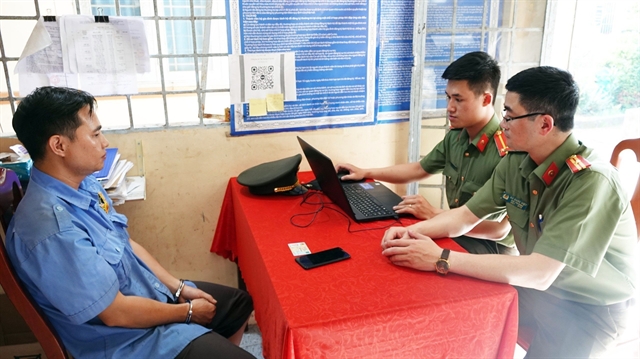

|
| Colonel Nguyễn Văn Thịnh, head of the Criminal Law and Judicial Reform Division in the Department of Legislation and Judicial Administrative Reform at the Ministry of Public Security. Photo vov.vn |
Voice of Vietnam (VOV) spoke to Colonel Nguyễn Văn Thịnh, head of the Criminal Law and Judicial Reform Division in the Department of Legislation and Judicial Administrative Reform at the Ministry of Public Security, about the proposal of using electronic tags to monitor individuals under house arrest to prevent their disappearance or reoffending.
Could you elaborate on new points in the draft amended Law on Execution of Criminal Judgments?
The 2009 Law on Execution of Criminal Judgments, which took effect on January 1, 2020, has created an important legal basis for the enforcement of criminal judgments. Since then, this work has been performed with high efficiency.
However, after more than four years of implementation, changes in the socio-economic conditions and the fact that some legal provisions have shown shortcomings have raised an urgent need to revise this law.
The proposed amendments focus on three new, outstanding policies. First, there will be solutions to improve the effectiveness of criminal judgment enforcement for community-based punishments (not prison sentences).
That means applying science and technology, information technology and digital transformation to improve efficacy.
The second major policy is to apply scientific and technological advances and digital transformation in the arrangement and management of the execution of prison sentences at detention facilities.
The third major policy is to resolve obstacles of the 2019 Law and make amendments to suit current and future practical requirements.
Why has the draft law’s drafting committee proposed these three major policies?
As I previously stated, despite the fact that the 2019 Law on Execution of Criminal Judgments has established a significant legal foundation for the enforcement of criminal judgments over the past few years, we must implement the developments made in both our nation and the world because of the swift changes in both national and international socioeconomic conditions.
Advances in science and technology, especially digital transformation, have changed rapidly in the world, and even in our country. Therefore, in order to increase this work's maximum efficiency in the future, we must use those advancements to the management of criminal judgment enforcement.
One of the new points of the draft law is using electronic tags to monitor individuals under house arrest. Could you tell us why this has been proposed?
Our execution of sentences has two types: imprisonment in detention facilities and executing sentences outside of prison or we can say in the community.
In terms of how prison sentences are carried out, we have essentially applied them quite sternly and tightly in detention centres in recent years.
In recent years, the success of community-based sentencing, such as probation, non-custodial reform, suspended sentences and prohibitions from leaving the home, has not been very high.
The management of criminals outside of the community is mainly administrative and manual through the management and supervision of local authorities, agencies and relevant units, falling short of expectations.
There have been reports of people serving community-based criminal penalties, such as suspended sentences and non-custodial reform, escaping the area without alerting their managers. They even perpetrated additional crimes elsewhere that the managers in charge of this punishment are unable to keep an eye on or control.
We have suggested utilising electronic tags for individuals serving sentences in the community because we are aware of these deficiencies and because of the advancements in science, technology and digital transformation that have occurred in the globe and in our nation.
For these people, in addition to the obligations stipulated in the Law on Execution of Criminal Judgments, we have added a provision that they must comply with a monitoring solution of using electronic devices.
The authorities and management organisations will be able to keep a tight eye on every move made by people serving prison sentences in the community thanks to that electronic equipment.
These individuals can be stopped from fleeing or from carrying out other criminal activities.
Could you elaborate on electronic tags proposed in the law? What exactly are they?
Actually, we refer to the experiences of other countries in the world for this proposal.
Many developed countries have applied them. According to our observations, not only highly developed countries such as the US, Russia, South Korea but also countries in the Southeast Asian region, such as Thailand, have applied this measure.
This measure is simple, not as complicated as we imagine. For example, in Russia and the US, they have devices worn on their hands and ankle.
The person serving the sentence just needs to wear them on their hands and feet for monitoring.
The wearer of the electronic device will have their movements tracked and information will be transmitted to the criminal judgment enforcement agency's data management centre.
The device will notify the management centre if the owner of the electronic tag takes it off, purposefully damages it, or causes it to stop working.
We will then apply punishment for this action.
To suggest changes to the law, we are creating an impact assessment policy.
Whether it is an ankle or wrist-worn gadget, research and learning from global experience are continually being done on it.
It is anticipated that we will be able to conduct research and designate appropriate agencies to investigate and produce these kinds of gadgets, enabling us to wear them on certain body parts.
In the world, people mainly wear them on their hands or ankles, and they do not affect the health of the person serving the sentence.
When setting out the requirements for producing such devices, do we aim to ensure a certain aesthetic, not creating pressure for the person serving the sentence?
Yes we do. The wearer has certain rights even though they are the ones who were found guilty and have to complete their sentence. Our goal is to provide technological equipment that don't interfere with the sentenced's other rights or sense of aesthetics.
It can be designed to be a wearable gadget, similar to a bracelet or watch.
However, we must decide that people who are found guilty and sentenced to prison or the community must be required to adhere to the terms of their sentence.
They will have certain rights restricted.
We will have to calculate and research how to ensure the best optimisation so as not to affect the person serving the sentence too much.
What does the drafting committee expect from the amended law in terms of overcoming the current shortcomings?
Our biggest expectation is the solution to apply science-technology and digital transformation in improving the effectiveness of criminal execution in the community. Our Party and State have long proposed this policy in Resolution 49 on judicial reform, and we will gradually reduce prison sentences and increase community-based penalties.
However, due to the low effectiveness of community sentence enforcement, we have not been bold enough to apply many community-based sentences.
We have applied many measures at detention facilities.
This time we expect the most that we will apply information technology through electronic monitoring devices as mentioned above, in order to improve the effectiveness of community-based sentence enforcement. From there, competent authorities and courts will be bolder in applying community-based sentences. VNS




















